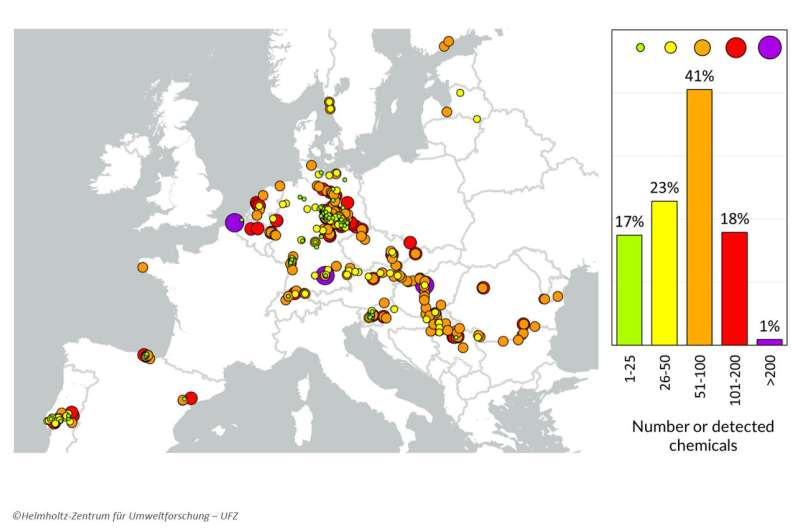This article has been reviewed according to Science X's editorial process and policies. Editors have highlighted the following attributes while ensuring the content's credibility:
fact-checked
trusted source
proofread
Mapping chemical footprints in European streams

Many pesticides, industrial chemicals, and pharmaceuticals, as well as their degradation products, end up in streams and rivers after use.
A team of environmental chemists at the UFZ has therefore taken a closer look at 610 chemicals with known occurrence patterns or problematic effects and analyzed whether and in what concentrations they occur in European watercourses—from large rivers such as the Elbe, Danube, and Rhine to the Ebro and Tagus on the Iberian Peninsula to smaller streams in agricultural regions of Germany.
After analyzing 445 samples from 22 rivers, the researchers detected 504 of the 610 chemicals. They found 229 pesticides and biocides and 175 pharmaceutical chemicals, as well as surfactants, plastic and rubber additives, per- and polyfuoroalkyl substances (PFAS), and corrosion inhibitors.
They detected up to 50 chemical substances in 40% of the samples and 51–100 chemicals in a further 41%. In four samples, they were even able to detect more than 200 organic micropollutants. They detected the most substances—241 chemicals—in a water sample taken from the Danube.
In the samples, the environmental chemists most frequently found N-acetyl-4-aminoantpyrine, which is a degradation product of the analgesic metamizole. Little is known about the effects of this substance on freshwater ecosystems.
"For many of these metabolites, it is unclear how harmful they are to the environment. We still lack the necessary knowledge," says UFZ environmental chemist Saskia Finckh, co-lead author of the study. However, the negative effects of other substances detected in the waters have already been researched.
One of the most common of these substances is the anticonvulsant carbamazepine, which is not readily biodegradable in bodies of water. It also impairs the reproductive capacity of invertebrates and delays the development of fish. Carbamazepine is, therefore, already on the watch list of the Federal Environment Agency (UBA) and is one of 23 other proposed priority substances to be added to the EU Water Framework Directive.
The effect of some other substances also frequently detected in the samples is also known. For example, the UFZ researchers frequently found the insecticides diazinon and fipronil, both of which are extremely harmful to aquatic invertebrates. In total, the chronic risk thresholds for invertebrates were exceeded for more than 70 chemicals detected in the waters. This means that prolonged or repeated exposure can lead to developmental disorders, among other things.
Many of the individual organic micropollutants are a problem for water bodies in their own right. However, there is an additional one to worry about. "The range of chemicals that are discharged into water bodies is a big problem. We still know far too little about the additive effects of these substances when they mix with each other", explains Dr. Eric Carmona, UFZ environmental chemist and co-lead author.
In order to be able to assess the impact of these mixing effects on the organisms living in the watercourses, the researchers applied the concept of the chemical footprint, which quantifies the potential of chemical mixtures to affect water quality—specifically, what chance of survival in aquatic organisms such as fish, crustaceans, and algae have at a particular site. The chemical footprint is calculated by relating the concentration of a chemical at a site to the expected effect.
The values for the chemicals detected are then summed. For each of these groups of organisms, there is a scientific limit value. Exceedances of this value may support the disappearance of vulnerable species from the ecosystem. The scientific limit values were exceeded in 74% of the samples tested. The risk is particularly high for crustaceans; at 15% of the sites surveyed, it is even acute, which means that the animals have little chance of survival at these sites.
The UFZ researchers conclude that despite many improvement measures, there are still too many chemicals in European waters. At many sites, the limit values are exceeded.
"Our data also show that it is not just individual substances but rather the large number of substances that contribute to this problem," says Finckh. It is, therefore, necessary to include even more chemicals in chemical water monitoring for the implementation of the EU Water Framework Directive because these have not yet been evaluated in an environmental context. More measurement data are also needed.
"It is often completely unclear what effects chemicals have on organisms in the water and in what concentrations," says Carmona. In these cases, model-based values have been used; however, these lead to greater uncertainty than the effect values measured. "Above all, we should be focusing more on their mixtures when assessing chemicals," says Finckh.
The findings are published in the journal Environment International.
More information: Saskia Finckh et al, Mapping chemical footprints of organic micropollutants in European streams, Environment International (2023). DOI: 10.1016/j.envint.2023.108371
Provided by Helmholtz Association of German Research Centres




















